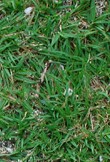 Bermudagrass is a perennial grass native to India and Africa and was introduced into North America in 1751. It is now found in most of the continental United States and is considered a noxious weed in some. This weedy Bermudagrass is a descendant of the cultivar ‘Coastal’ which was widely planted for lawns in the Southeast in the early 20th century because of its heat and drought tolerance. It has also been used for sports fields because of its fast growth and ability to recover quickly when damaged but these same characteristics have made it a very troublesome and difficult to control weed. Bermudagrass has invaded croplands, turfgrass, orchards, and gardens where a single sprig can cover a square yard in only a few weeks. Although gardeners have given the weed the name “devilgrass” many cultivars have been developed as turfgrass or forage for livestock.
Bermudagrass is a perennial grass native to India and Africa and was introduced into North America in 1751. It is now found in most of the continental United States and is considered a noxious weed in some. This weedy Bermudagrass is a descendant of the cultivar ‘Coastal’ which was widely planted for lawns in the Southeast in the early 20th century because of its heat and drought tolerance. It has also been used for sports fields because of its fast growth and ability to recover quickly when damaged but these same characteristics have made it a very troublesome and difficult to control weed. Bermudagrass has invaded croplands, turfgrass, orchards, and gardens where a single sprig can cover a square yard in only a few weeks. Although gardeners have given the weed the name “devilgrass” many cultivars have been developed as turfgrass or forage for livestock.

 Description: Bermudagrass is low growing and wiry. The gray-green leaves are thin blades, creased down the center, and measure 2 to 7 inches long. They have rough margins and are produced on opposite sides of the flattened stem. Three to seven finger-like flowering spikes are produced in terminal clusters, each 1 to 3 inches long and flattened. Lance-shaped seeds are produced that can remain viable in the soil for two years or more. Although bermudagrass produces seeds it spreads primarily by its stolons and rhizomes. The stolons are flat, smooth, usually bent and lie above ground whereas the rhizomes are scaly and lie below ground to a depth of 6 inches or more. Both stolons and rhizomes produce roots at the nodes thus creating new plants.
Description: Bermudagrass is low growing and wiry. The gray-green leaves are thin blades, creased down the center, and measure 2 to 7 inches long. They have rough margins and are produced on opposite sides of the flattened stem. Three to seven finger-like flowering spikes are produced in terminal clusters, each 1 to 3 inches long and flattened. Lance-shaped seeds are produced that can remain viable in the soil for two years or more. Although bermudagrass produces seeds it spreads primarily by its stolons and rhizomes. The stolons are flat, smooth, usually bent and lie above ground whereas the rhizomes are scaly and lie below ground to a depth of 6 inches or more. Both stolons and rhizomes produce roots at the nodes thus creating new plants.
 Control: Controlling Bermudagrass is very difficult. Begin by digging out the plants in fall and spring trying to get every piece of stolon and rhizome. This is virtually impossible so many diggings are necessary. Mulching with woodchips will slow down the spread of Bermudagrass. It will grow through and over the mulch but will be more easily removed than if it were growing through soil. Better results can be achieved if landscape fabric is placed under the mulch, care being taken to overlap the sheets so the weed does not grow through spaces between sheets. Black polyurethane placed over high infestations of Bermudagrass for 6 to 8 weeks in summer after mowing and irrigating gives good results.
Control: Controlling Bermudagrass is very difficult. Begin by digging out the plants in fall and spring trying to get every piece of stolon and rhizome. This is virtually impossible so many diggings are necessary. Mulching with woodchips will slow down the spread of Bermudagrass. It will grow through and over the mulch but will be more easily removed than if it were growing through soil. Better results can be achieved if landscape fabric is placed under the mulch, care being taken to overlap the sheets so the weed does not grow through spaces between sheets. Black polyurethane placed over high infestations of Bermudagrass for 6 to 8 weeks in summer after mowing and irrigating gives good results. Solorization with clear plastic for three to five weeks when solar radiation is high dramatically reduces the Bermudagrass population especially when preceded by a through digging. A deep edging slows the spread of Bermudagrass but the weed can grow under most barriers. Post-emergent herbicides containing sethoxydim , fluazifop can be helpful for bermudagrass control in most garden beds where they kill grasses but not the ornamental plants. Post-emergent herbicides such as glyphosate are also effective against Bermudagrass but many applications may be necessary.
Solorization with clear plastic for three to five weeks when solar radiation is high dramatically reduces the Bermudagrass population especially when preceded by a through digging. A deep edging slows the spread of Bermudagrass but the weed can grow under most barriers. Post-emergent herbicides containing sethoxydim , fluazifop can be helpful for bermudagrass control in most garden beds where they kill grasses but not the ornamental plants. Post-emergent herbicides such as glyphosate are also effective against Bermudagrass but many applications may be necessary.